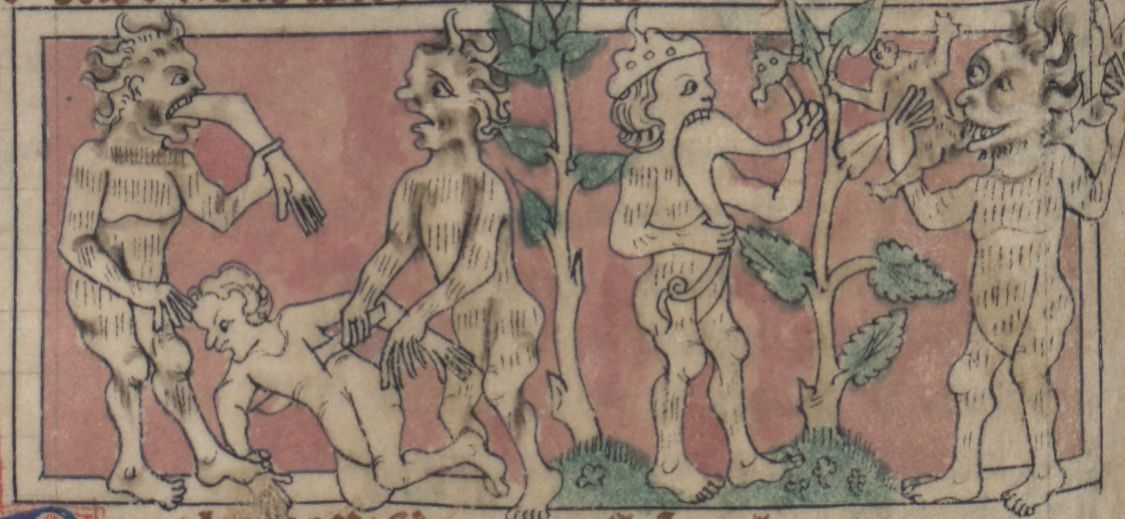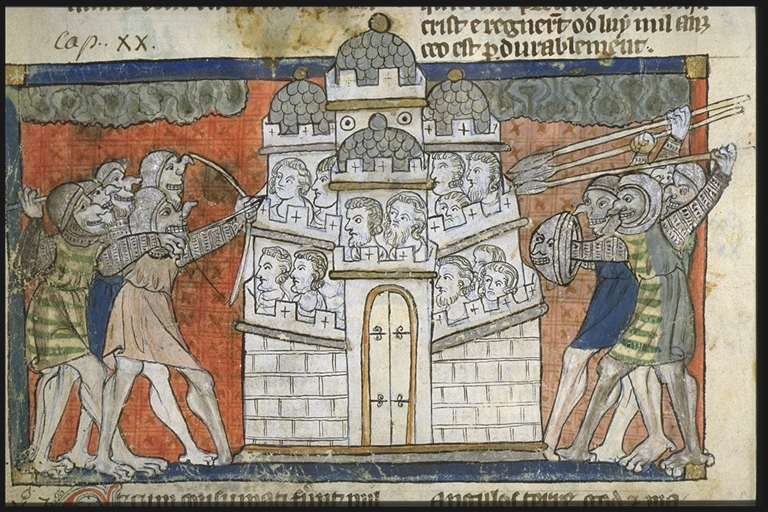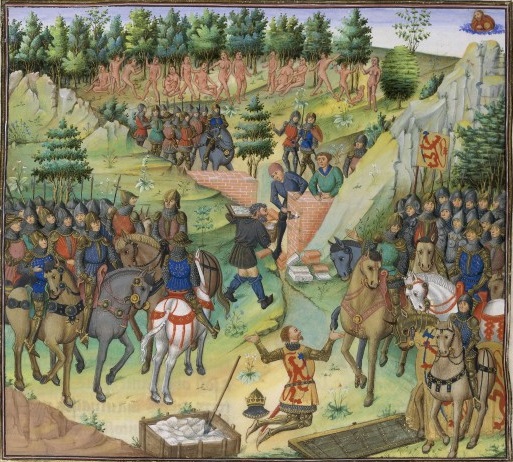In the middle of the ninth century, the Abbasid caliph al-Wathiq had a bad dream. He saw a breach open in a great wall set between mountains, a vision which immediately rang alarm bells for this ruler of a vast empire stretching from India to Sicily. A prophecy in the Koran—inherited from Jewish and Syriac, Coptic and other Christian traditions in the Middle East—had claimed that the world would end after the collapse of a wall built by Alexander the Great, a wall that fenced off the barbaric hordes of “Gog and Magog” from the realms of men. When the wall crumbled, Gog and Magog’s wild creatures would “rustle down from every height,” drink all the rivers and lakes dry, eat the flesh of both men and animals, and shoot arrows upwards at the heavens until the missiles fell back to earth tipped with the blood of angels.
Al-Wathiq wouldn’t sit idly on such ominous portents. Like Persian and Roman emperors before them, caliphs wore the mantle of universal kingship, nominal sovereignty over the whole world; the apocalypse was a rather direct and final rebuke of their temporal power. As the historian and geographer Ibn Khordadbeh records in the Book of Routes and Kingdoms, al-Wathiq dispatched a man named Sallam the Translator, who could speak thirty languages, to go off in search of Alexander’s wall with fifty men and two hundred mules. Sallam would return to the caliph’s court in Samarra in Iraq over two years later with only fourteen men and twenty-three mules, but he had acquired reassuring news: the wall at the edge of the world, separating mankind from its doom, still stood.
It was made from iron and copper, he said, striped like a tiger with bands of black and shining gold. The metal was so perfectly fused to the flanking mountains that air couldn’t penetrate from the other side. According to Sallam, there was only one blemish in the wall: a crack “as wide as a thin thread.” He scraped a little iron from the crack into his handkerchief and brought these morsels to the caliph, the proof the world wasn’t about to end.



Rulers have long agonized over walls, their solidity and their permanence. Perhaps this is because—as al-Wathiq seemed to have surmised—walls don’t last forever, and to build a wall is to know that one day it will fall. But despite the secular and materialist convictions of our age, 21st century rulers are wedded to magical thinking more fanciful even than al-Wathiq’s eschatology, building border wall after border wall in an unceasing effort to make our imaginary lines more real and enduring. When the Berlin Wall fell in 1989, there were 15 border walls around the world. History had supposedly come to an end, jealous nationalisms were consigned to the past, and the world was becoming “flat.”
Instead, the 21st century has seen a proliferation of border walls, with 77 carving up the earth today.
Their power is often more symbolic than it is concrete. Not just bulwarks to preserve the order of the state—to keep the barbarians at bay—these walls loom as evidence of the apocalypse beyond, proving that the order of the state is what stands between us and chaos. If Americans clamor for a wall on the border with Mexico, it’s because they see existential threats on the other side, swarming hordes of migrants, caravans of MS-13 gang members and Islamist terrorists slouching towards the Rio Grande. Gog and Magog are here and about to apply for asylum. Many Trump voters want the wall not just to feel safe but to confirm that their fantasies are real.
A monumental wall always conjures the impression of radical difference. Writing from his cozy remove in civilized Constantinople, the sixth-century Byzantine historian Procopius sensationalized Hadrian’s Wall in the fog-bound north of the old Roman province of Britannia. He wanted to ascribe great power to the wall:
“The air and the soil and everything else is different on the two sides of it. For to the south of the wall there is healthy air… and many men dwell there… and the crops flourish. But on the other side everything is the opposite of this… innumerable snakes and all kinds of wild beasts occupy the place as their own… and the natives say that if a man crosses the wall and goes to the other side he forthwith dies, unable to bear the pestilential nature of the air.”
None of this was true, neither literally nor even figuratively. The landscapes on each side of Hadrian’s Wall were largely identical, as they are today. As historians of Roman Britain generally agree, the wall—which survives in fragments as a windswept jaunt for walkers—was not built as a border or as a barrier to keep the “barbarians” out; it was a monument, a stone testament to the imperial might that controlled restive tribes on both sides, and intended to remind them of that fact.
All walls face in two directions. The Roman limes in Germany—a 300 mile-long line of ramparts and towers separating Roman provinces from regions dominated by Germanic tribes—had a similar function, its wide ditches on the Roman side meant to limit movement leaving the empire, not just coming in. Rather than a barrier against an alien other, the border was a line of control, an attempt to pin down shifting, often amorphous populations. None of these fortifications remained in use for very long.
(I once hiked a bit of the limes Germanicus in the genteel wooded suburbs of Frankfurt, where the traces of even older Bronze Age ring-forts nudged up from the undergrowth, and it was easy to imagine millennia of states flickering to life before disappearing into the moss.)
The most famous great wall, in China, was never a single wall at all, but rather a patchwork of obstructions built in different eras for different reasons. Like the Roman walls, they weren’t manned consistently for long periods of time and rarely justified—in military terms—the enormous expense of their construction. Anybody who has walked the Great Wall’s reconstructed heights at Simatai, where the mountain-face drops impossibly and impassibly from the climbing line of the wall, can’t help but wonder how this wall could have had any strategic function whatsoever; what nomad army of horse-lords and wagon-trains would ever try to cross here? Instead, the crenellated towers, hovering on mountaintops like aeries, shouted the power of the state over the landscape.
Such walls are built because they can be, because a ruler can make the implausible real.
Over the centuries, scholars have long speculated about the actual location of the “gates of Alexander,” the wall Sallam the Translator supposedly visited for al-Wathiq. Somewhere behind the legend of Gog and Magog and Alexander’s wall, there lies the age-old tension of Eurasian life between the more settled, agricultural peoples of southern regions and the more mobile peoples of the northern steppes; the wall has invariably been imagined in that zone of migration, trade, and conflict. Some associate the legend of Sallam’s mission with the ancient fortifications at Derbent—the name derived from the Persian for “closed gate”—on the Caspian Sea in what is now Russia. Others locate it in the Darial Pass of the Caucasus Mountains and some look as far as the walls in China. More plausibly, perhaps, some scholars have eyed the 200-kilometer-long clay brick wall of Gurgan built by the Persian Sassanid Empire in the plains east of the Caspian Sea. Like all great walls, the “Red Snake” was an immense undertaking of centralized power, meant to limit movement from the steppes into more fertile agricultural regions to the south. It was abandoned after barely two centuries of sporadic use, overwhelmed by sand and earth, its brick ramparts cannibalized by locals.
Sallam’s account contains next to no information about the people obstructed by the wall, the creatures of Gog and Magog. Very little was known about them apart from the fact that they seemed to buzz. Twice a week, the commanders who manned the barrier—a responsibility handed down from father to son since the time of the wall’s construction by Alexander—would climb up to the wall and strike it with iron rods. On the other side, a commotion would rise like “the noise of a hornet’s nest.” Sallam claimed the defenders of the wall did this to remind the barbarians that the barrier was still protected, but it worked both ways: after guarding an unruffled frontier for centuries, the soldiers would have needed a reminder that their wall had any purpose.
Kanishk Tharoor






